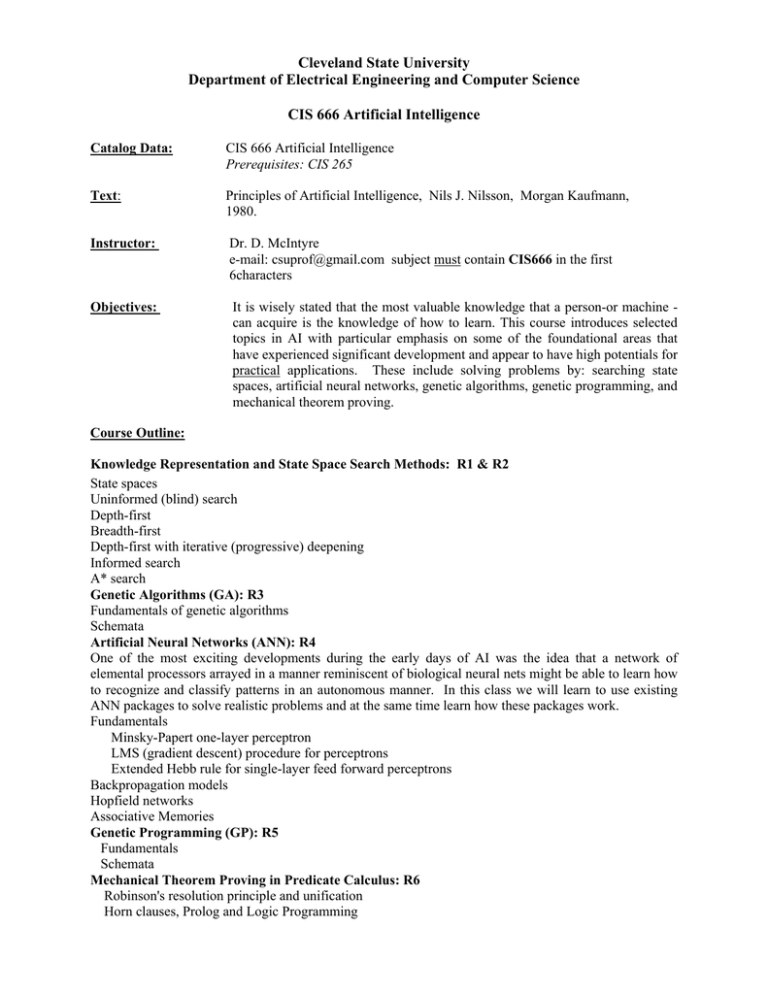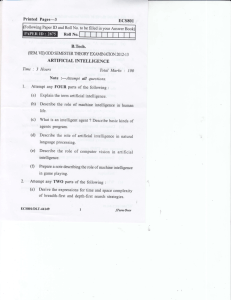Cleveland State University Department of Electrical Engineering and Computer Science
advertisement

Cleveland State University Department of Electrical Engineering and Computer Science CIS 666 Artificial Intelligence Catalog Data: CIS 666 Artificial Intelligence Prerequisites: CIS 265 Text: Principles of Artificial Intelligence, Nils J. Nilsson, Morgan Kaufmann, 1980. Instructor: Dr. D. McIntyre e-mail: csuprof@gmail.com subject must contain CIS666 in the first 6characters Objectives: It is wisely stated that the most valuable knowledge that a person-or machine can acquire is the knowledge of how to learn. This course introduces selected topics in AI with particular emphasis on some of the foundational areas that have experienced significant development and appear to have high potentials for practical applications. These include solving problems by: searching state spaces, artificial neural networks, genetic algorithms, genetic programming, and mechanical theorem proving. Course Outline: Knowledge Representation and State Space Search Methods: R1 & R2 State spaces Uninformed (blind) search Depth-first Breadth-first Depth-first with iterative (progressive) deepening Informed search A* search Genetic Algorithms (GA): R3 Fundamentals of genetic algorithms Schemata Artificial Neural Networks (ANN): R4 One of the most exciting developments during the early days of AI was the idea that a network of elemental processors arrayed in a manner reminiscent of biological neural nets might be able to learn how to recognize and classify patterns in an autonomous manner. In this class we will learn to use existing ANN packages to solve realistic problems and at the same time learn how these packages work. Fundamentals Minsky-Papert one-layer perceptron LMS (gradient descent) procedure for perceptrons Extended Hebb rule for single-layer feed forward perceptrons Backpropagation models Hopfield networks Associative Memories Genetic Programming (GP): R5 Fundamentals Schemata Mechanical Theorem Proving in Predicate Calculus: R6 Robinson's resolution principle and unification Horn clauses, Prolog and Logic Programming References upon which class notes are based: R1: Principles of Artificial Intelligence, Nils J. Nilsson, Morgan Kaufmann, 1980. R2: Formal Concepts in Artificial Intelligence, Rajjan Shinghal, Chapman & Hall, 1992. R3: Genetic Algorithms, D. E. Goldberg, Addison-Wesley, 1989 R4: Explorations in Parallel Distributed Processing: A Handbook of Models, Programs, and Exercises James L. McClelland and David E. Rumelhart, MIT Press 1988. http://www.stanford.edu/group/pdplab/pdphandbook/handbook.pdf R5: Genetic Programming: on the programming of computers by means of natural selection, J. Koza, MIT Press 1993. http://www.ru.lv/~peter/zinatne/ebooks/MIT%20-%20Genetic%20Programming.pdf R6: Programming in PROLOG, W. Clocksin & C. Mellish, Springer-Verlag (3d ed.), Chapter 10, 1987. Grading scheme: Late assignments: Assignments (3-4) Quizzes (2) Midterm Final 25% 10% 30% 35% Wed. Oct. 22, 8:00-10:00pm Mon. Dec. 8, 8:00-10:00pm Will be accepted up to the time that they are graded and handed back to the class. After that they are worth nothing. Penalty on late assignment TBD. Examination Policy: All examinations will be in class. No book or note can be used for tests unless otherwise indicated in the test. Make-Up Exam Policy: Ordinarily, no make-up examinations will be given. Make-up examination will be considered only in case of documented emergencies and only when the instructor is notified about the emergency as soon as possible. If this is not done, the grade is automatically 0 for that examination. It is the responsibility of the student to contact the instructor for arranging a make-up time. Written verification for the student's inability to take an exam will be required. Homework Policy: Students are responsible for all material covered in class and for those chapters of the text specified in the syllabus (unless told otherwise by the instructor).






